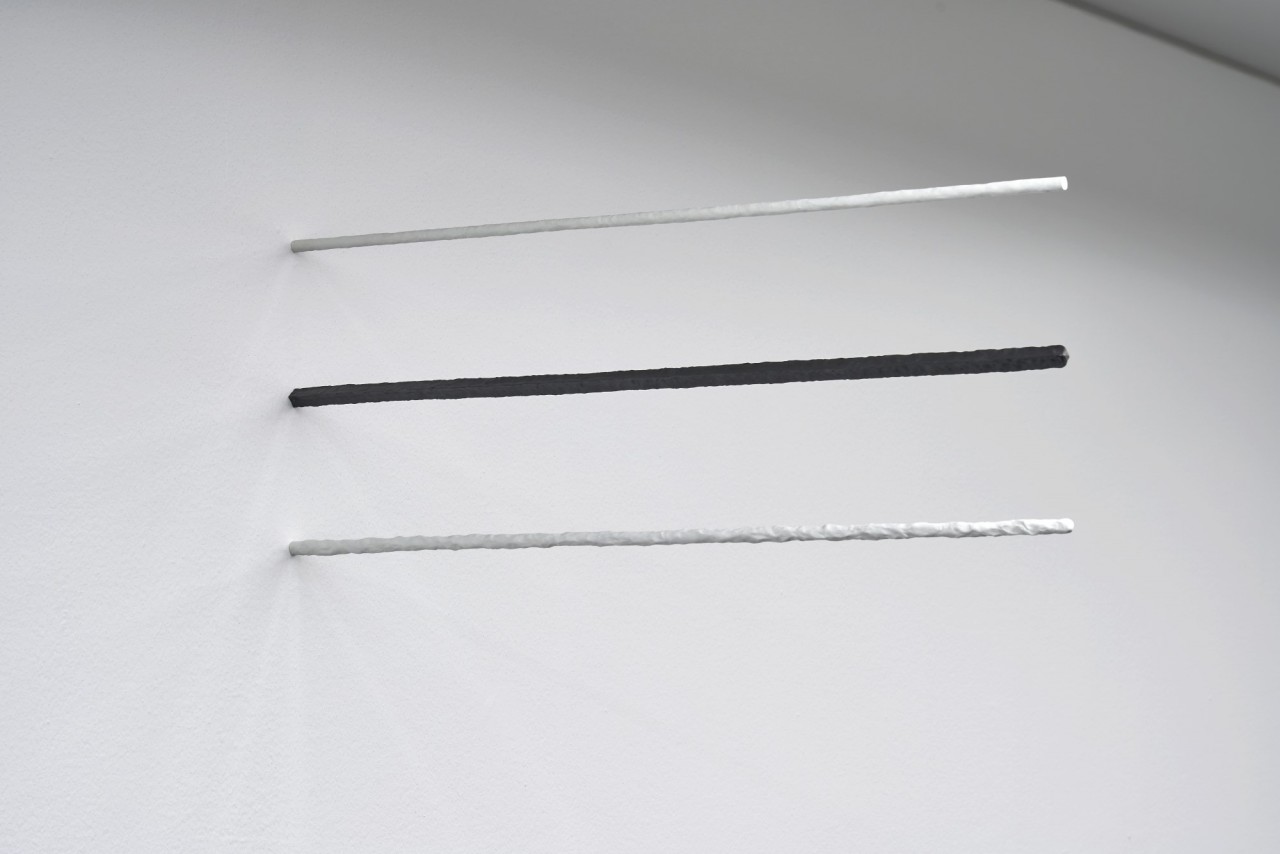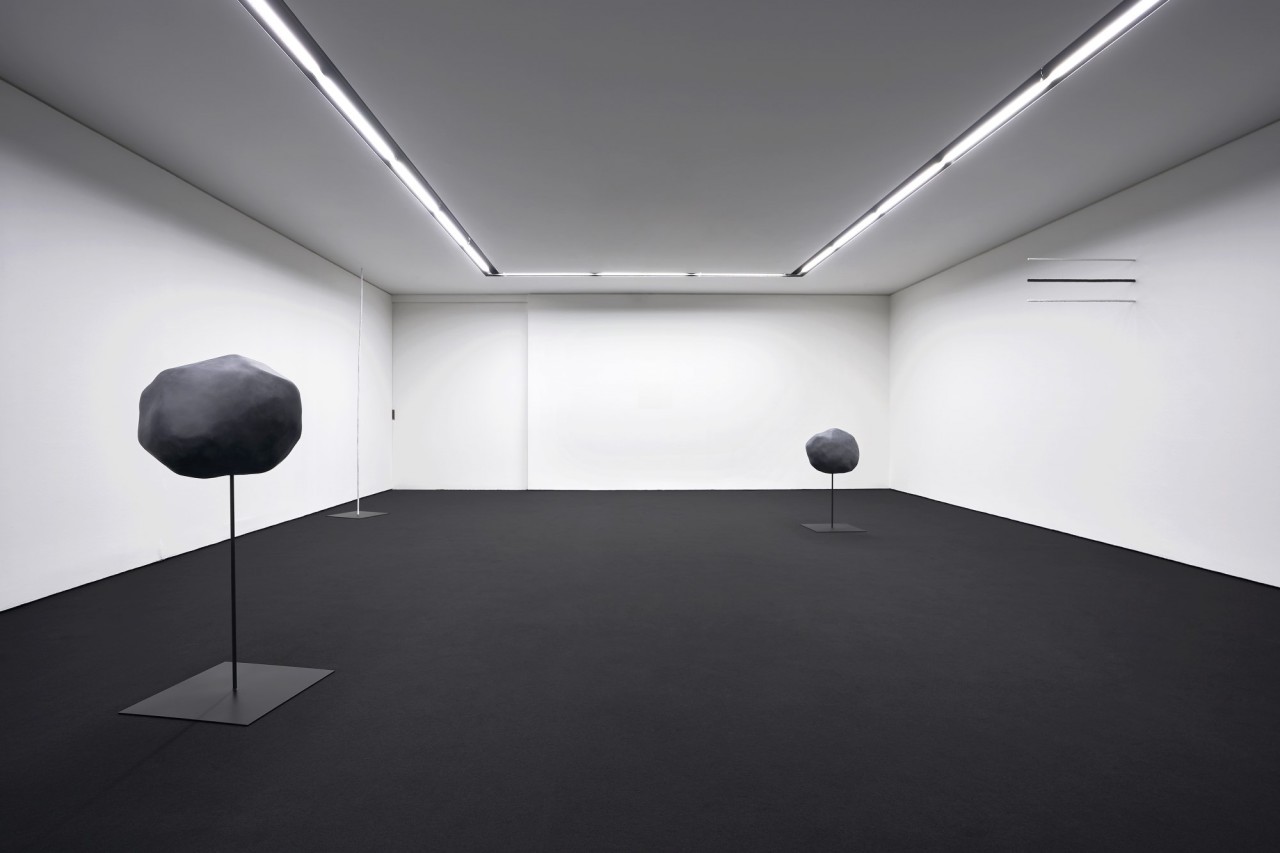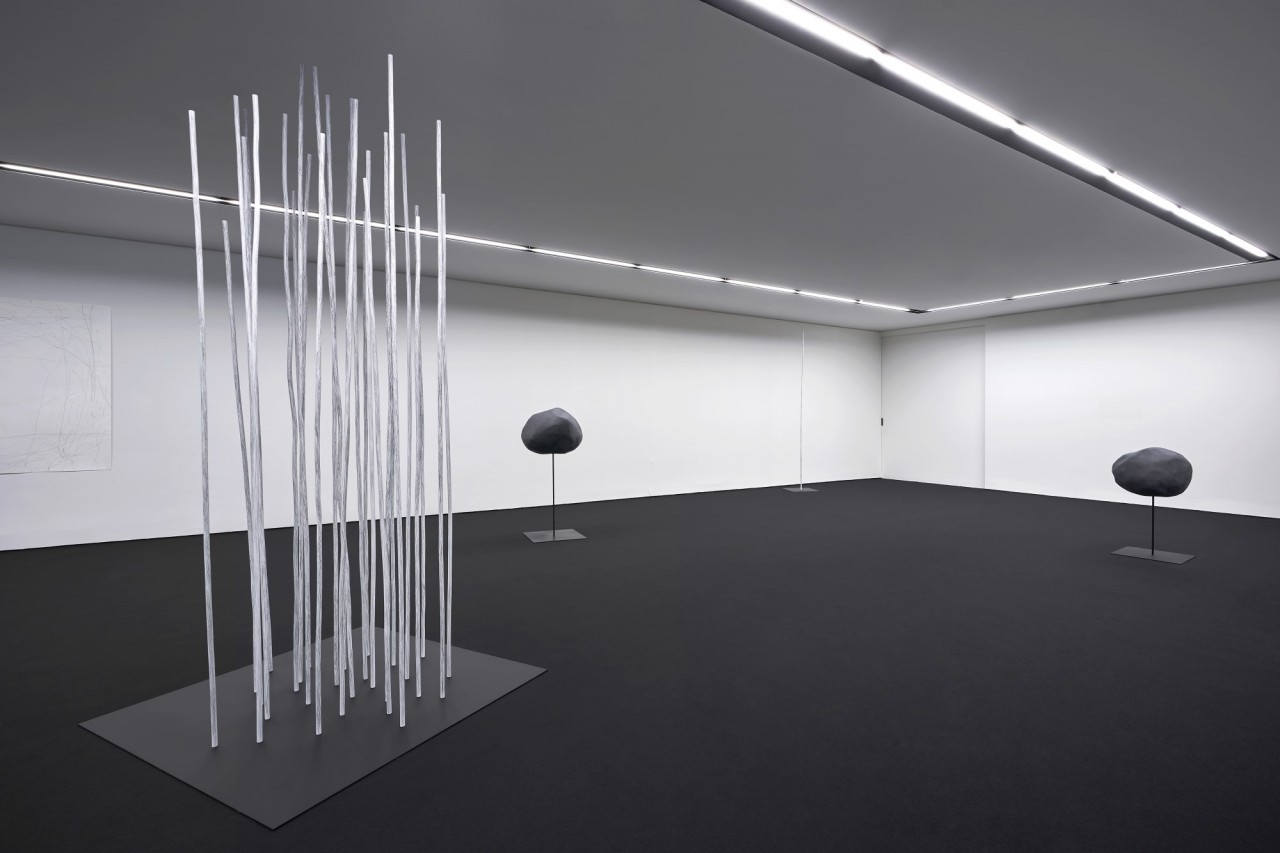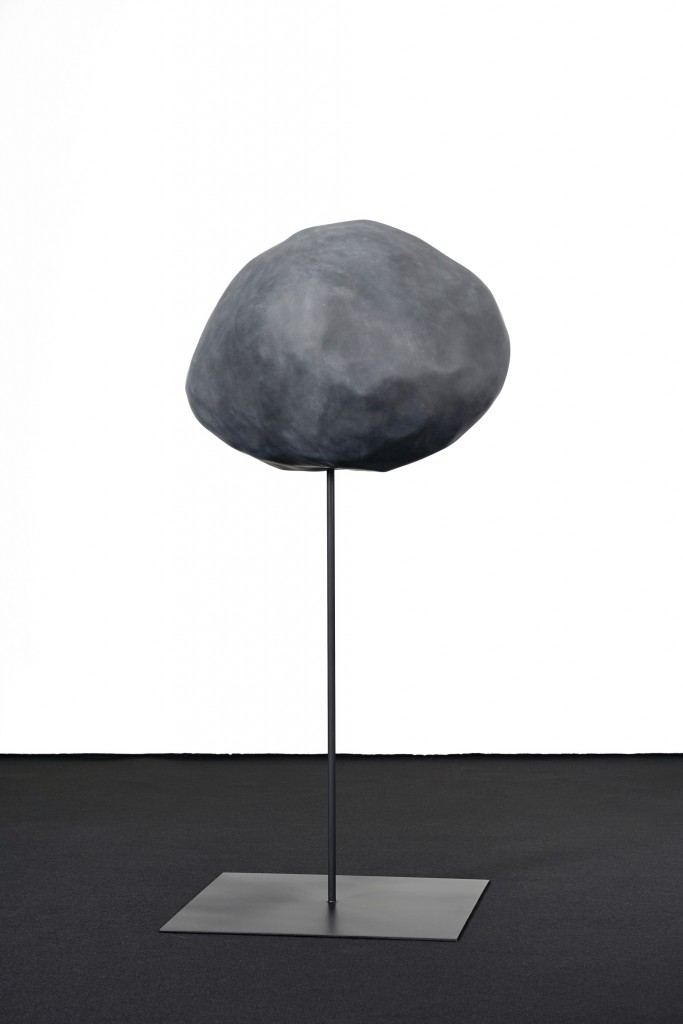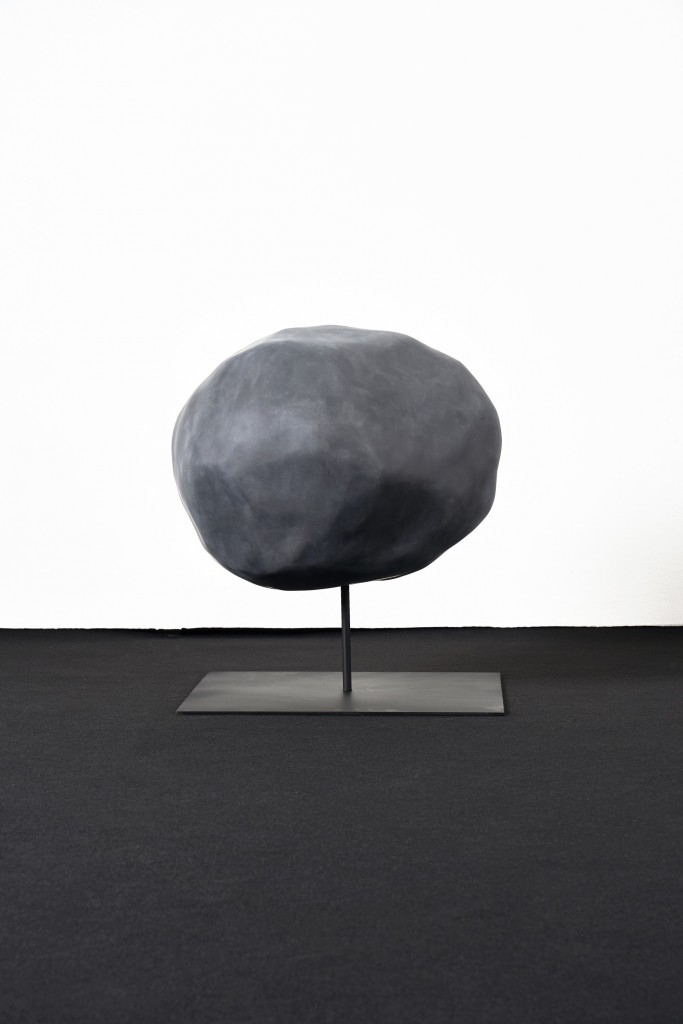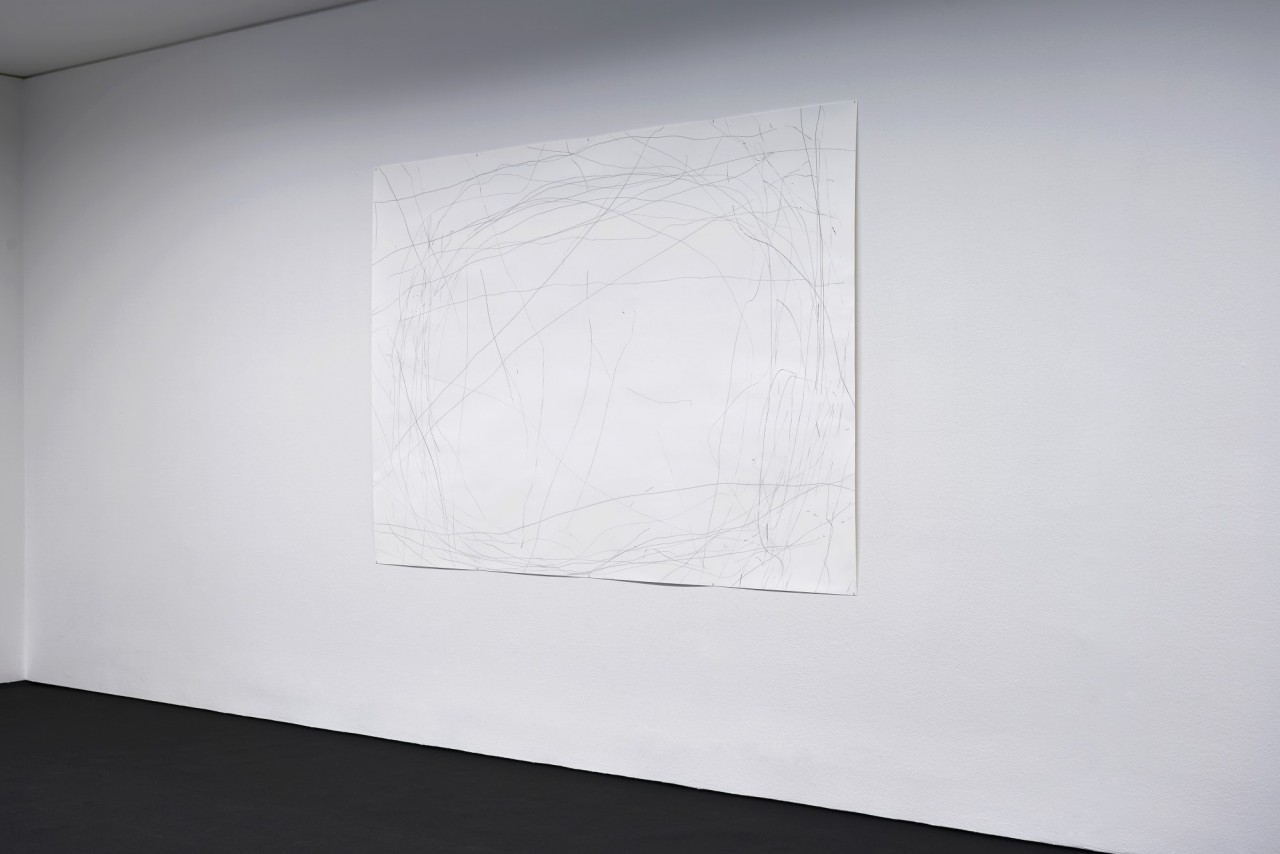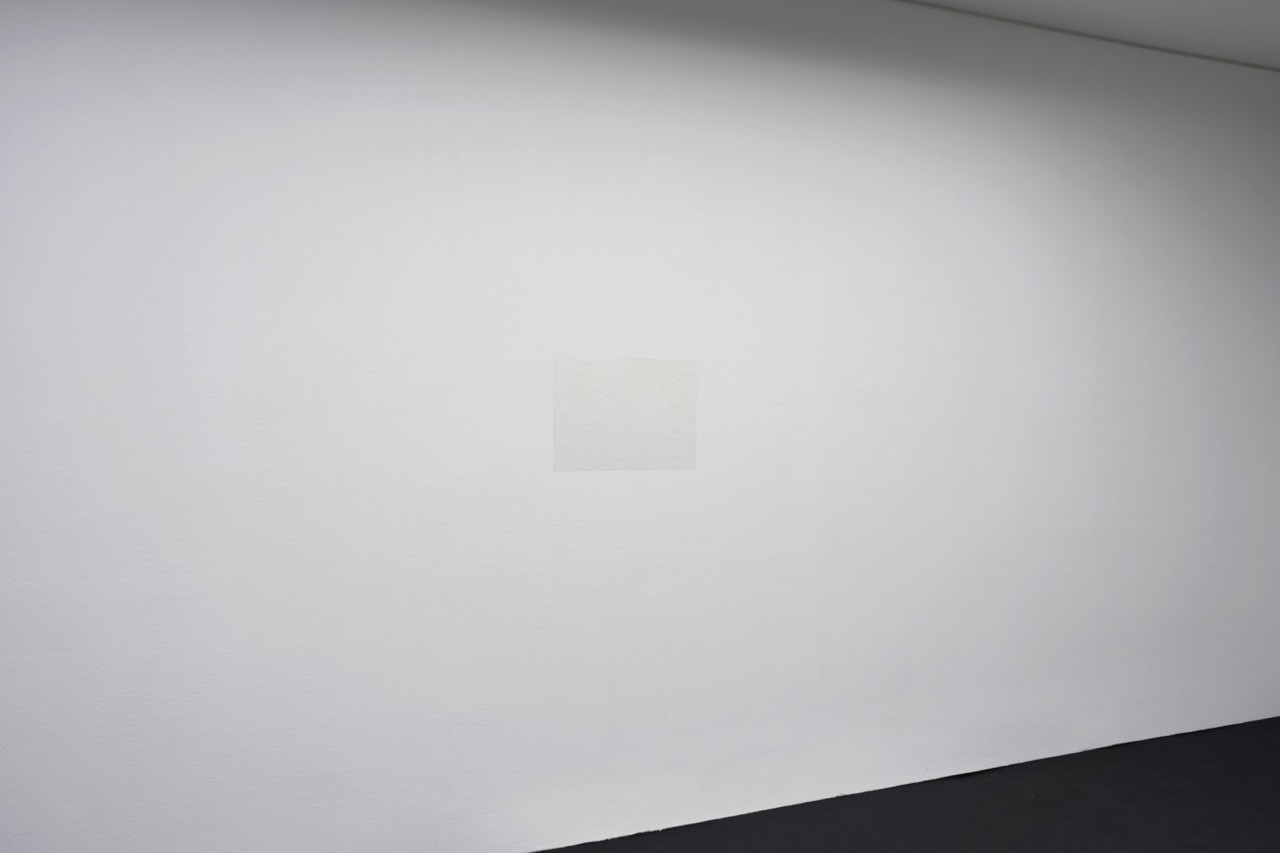Exhibitions
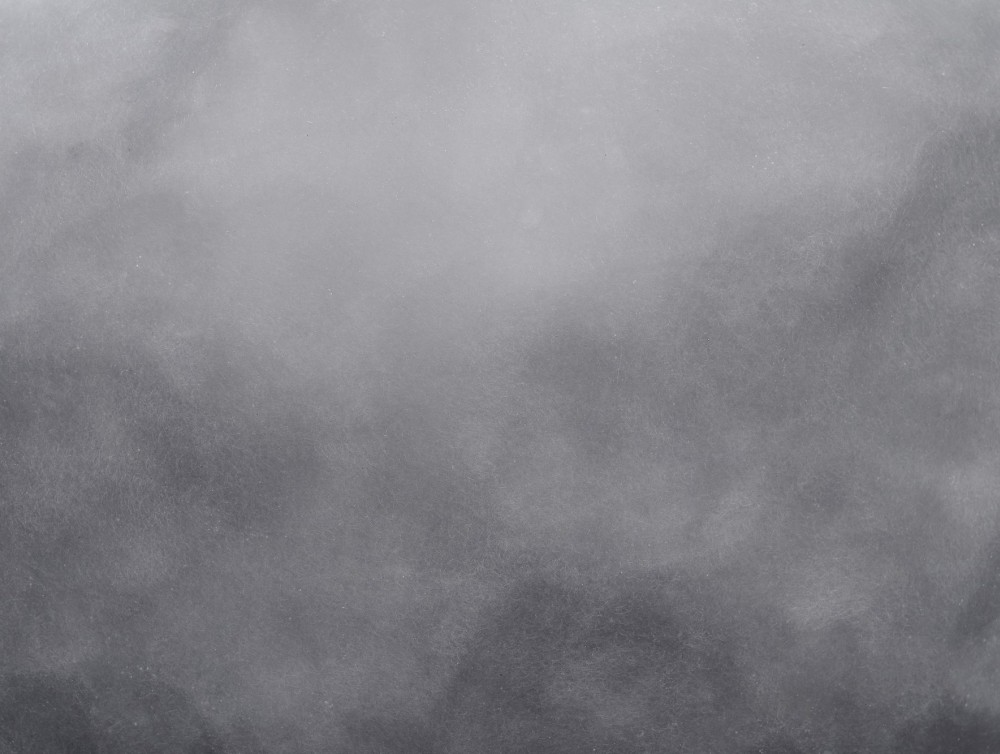
PERIGEE ARTIST #23 김인배
사랑, 기억하고 있습니까
2020.09.10. THU ~
2020.11.14. SAT
<선 사용법>
신승오(페리지갤러리 디렉터)
김인배는 지금까지 다양한 방식으로 인체를 변주하는 작업을 선보여 왔다. 그렇지만 이는 인간이 가지고 있는 감정이나 내면의 심리상태를 재현하기 위한 것이 아니라 하나의 주체로서 눈앞에 있는 객체를 어떻게 지각하고 인지하는가에 대한 탐구이다. 이를 위해 작가는 전시를 구성하는 설치 방식까지 고민하여 왔다. 그의 전시 설치는 작품들이 구조적으로 대구(對句)를 이루는 잘 구성된 무대 연출을 보는 듯 하다. 이와 같은 작업과 전시 방식에서 우리가 인식하게 되는 것은 객체를 인지하기 위한 시각적 도해는 학습된 경험, 지식 같은 관례에 의존하기에 곧 한계에 봉착한다는 점이다. 따라서 이러한 전시 구성은 기존의 지각 방식에 혼선을 불러오고 분산시켜 온전하면서도 불안정한 상황을 만들고자 하는 작가의 의도를 보여준다. 이렇게 그가 전시장에 배치하는 작업들은 각자의 고유한 위치를 점유하고 있지만 하나에 집중되는 것 보다는 서로 유기적으로 연결되면서 이내 흩어져 버린다. 그리고 이러한 이어짐은 우리를 어떤 목적성을 가진 결론으로 도달하기 위한 통로가 아니라 오히려 미궁으로 이끈다. 이와 같이 김인배의 작업은 우리가 시각을 통해 지각하는 것이 어떻게 무엇이 되는가에 대한 지속적인 관심을 보여준다. 대표적으로 예전 전시였던 《점, 선, 면을 제거하라》(2014)는 인간의 시각적 관념으로 설정해 놓은 기본단위인 점, 선, 면으로 객체를 인식하는 것이....
<How to Use Lines>
Seung Oh Shin (Director of Perigee Gallery)
Inbai Kim’s works have involved variations of the human body in a wide range of ways. Even still, they are not meant to represent inner emotions or psychological states; they are intended to explore how a subject perceives and recognizes an object before one’s eyes. To achieve this, Kim has concerned himself with how to install his pieces in venues. The method he uses usually results in well-constructed stage settings as if he were structurally forming an antithesis. Recognizable in his work and exhibition method is the fact that any visual illustration to perceive objects soon comes up against a limitation because it depends on conventions such as learned experience and knowledge. As a result, this work configuration arouses some confusion in its preexisting way of perception and signals the artist’s intent to bring about a normal yet unstable situation through a distributed arrangement. Each work he displays in this way occupies its own arena but they soon scatter instead of coming together at a single point since they are organically assoc....
신승오(페리지갤러리 디렉터)
김인배는 지금까지 다양한 방식으로 인체를 변주하는 작업을 선보여 왔다. 그렇지만 이는 인간이 가지고 있는 감정이나 내면의 심리상태를 재현하기 위한 것이 아니라 하나의 주체로서 눈앞에 있는 객체를 어떻게 지각하고 인지하는가에 대한 탐구이다. 이를 위해 작가는 전시를 구성하는 설치 방식까지 고민하여 왔다. 그의 전시 설치는 작품들이 구조적으로 대구(對句)를 이루는 잘 구성된 무대 연출을 보는 듯 하다. 이와 같은 작업과 전시 방식에서 우리가 인식하게 되는 것은 객체를 인지하기 위한 시각적 도해는 학습된 경험, 지식 같은 관례에 의존하기에 곧 한계에 봉착한다는 점이다. 따라서 이러한 전시 구성은 기존의 지각 방식에 혼선을 불러오고 분산시켜 온전하면서도 불안정한 상황을 만들고자 하는 작가의 의도를 보여준다. 이렇게 그가 전시장에 배치하는 작업들은 각자의 고유한 위치를 점유하고 있지만 하나에 집중되는 것 보다는 서로 유기적으로 연결되면서 이내 흩어져 버린다. 그리고 이러한 이어짐은 우리를 어떤 목적성을 가진 결론으로 도달하기 위한 통로가 아니라 오히려 미궁으로 이끈다. 이와 같이 김인배의 작업은 우리가 시각을 통해 지각하는 것이 어떻게 무엇이 되는가에 대한 지속적인 관심을 보여준다. 대표적으로 예전 전시였던 《점, 선, 면을 제거하라》(2014)는 인간의 시각적 관념으로 설정해 놓은 기본단위인 점, 선, 면으로 객체를 인식하는 것이 아니라 ‘나’와 대상의 상대적 거리를 통해 주체로서 객체를 보는 하나의 시선과 ‘나’가 객체들에 노출되는 다층적 시선을 드러내었다. 그리고 몸이 인지하는 통합된 감각과 함께 분열된 시각을 동시에 연출하였다. 이번 전시 《사랑, 기억하고 있습니까》¹ 도 이러한 연장선상에 놓여있다.
《사랑, 기억하고 있습니까》는 근작들인 <뒷모습>, <측면의 측면>, <측면의 반측면>에서 작가가 보여주고 있는 선적인 형태에 대한 연구에서 비롯된다. <뒷모습>은 선으로 이루어진 형태 그 자체와 그로 인해 구분되는 비어진 공간 그리고 이를 틀로 삼아 선으로 그려나간 동일한 제목의 드로잉이다. 이는 뒷모습이라는 제목으로 인해 쉽게 인체를 떠올릴 수 있다. 하지만 드로잉이나 <측면의 반측면>, <측면의 측면>같이 면을 부각시키는 재료를 사용하면 보는 위치에 따라 인체에 대한 인식은 모호해지며, 작품들은 서로가 서로를 기반으로 하고 있기에 개별적으로 작품을 인지하는 방식에 영향을 주고받게 된다. 이런 방식에 더하여 <건드리지 않은 면>에서 작가는 연근의 단면을 기본 형태로 잡고 그것을 기반으로 조각들을 맞춰서 쌓아 올려 나간다. 여기서 최종적으로 완성된 형태는 개별적이지만 독립적이지 못하고 모본의 형태에 일정부분을 이어받은 결과물이다. 또한 연근이 가지고 있는 특징인 구멍들은 실제로 형태 안에 존재하지만 관객들은 그것을 보지 못하고 상상할 수 밖에 없다. 이렇게 그는 꾸준하게 어떤 객체를 감각하고 지각하는 것에 대해 ‘선’ 이라는 가장 단순한 형태의 연구를 통해 집중하고 있음을 알 수 있다. 이제부터는 이번 전시에서 선보이는 작품을 개별적으로 살펴보자. <선이 되려는 선>은 바닥에서 수직으로 서 있고, <극중극>은 벽에서 수평으로 놓여지지만 엄격하지 않고, 두 작품 모두 그 자체로는 긴장감없이 느슨하다. 둘은 서로의 방향성을 드러내는 것 같으면서도 정적이며, 벽에서의 수직과 수평, 바닥에서의 수평과 수직이 대구를 이룬다. 또한 <선이 되려는 선>은 선 위에 선을 그렸고, <극중극>은 하나의 선을 분리하여 확대한 모습이다. 이렇게 작가는 선을 분해, 결합, 축소, 확대하면서 서로에게 겹쳐지고 분리되는 다양한 변주를 이어나간다. 여기에 더해 <일정한 거리>는 <삼면화: 크기, 동작, 개수>를 다각도로 촬영하고 3D프린터로 출력한 축소판이다. 이 덩어리를 관객이 손에 들게 되면 작품과 거리가 더 없이 가까워진다. 하지만 전시장에서는 여전히 눈과 거리를 유지하는 또 다른 비슷한 형태의 덩어리를 만나게 된다. 그리고 내 손에 있는 것이 눈으로 보고 있는 것과 크기가 동일하지 않으며, 내가 손에 쥐고 있는 촉감과 눈으로 보는 시각이 혼선된다. <멀리서 그린 그림>은 말 그대로 언제 구부러질지도 모르는 불안한 긴 알루미늄 봉에 연필을 연결하여 멀리서 아이맥스 스크린 비례 안에 선들을 그려 넣었다. 이렇게 그려진 선은 작가와의 물리적 거리로 인해 완벽한 통제에서 벗어나 자유로운 움직임을 보여주는 것 같으면서도 어쩔 수 없이 작가의 의도적 행위에 귀속될 수 밖에 없다. 또 다른 드로잉인 <가장 큰>은 앞의 작업보다 더욱 작아진 아이맥스 스크린 비례를 가진 종이에 그려져 있다. 그리고 화면의 경계에 거의 스치듯이 빗겨 그려져 선이 화면 안에 분명히 들어와 있으면서도 오히려 화면 밖으로 벗어나려는 움직임과 확장된 공간성을 보여준다. 여기서 보이듯이 그의 작품들은 이번에도 대구를 이룬다. 이제 다시 전체의 전시 구조로 시선을 확대해 보자. 이번 전시에서 사용하는 선에 대한 개념은 단순하면서도 복잡하다. 그의 작업에서 선은 가느다란 하나의 존재로서 독립적으로 인식되는 한편, 복잡한 선들의 중첩으로 인해 온전히 하나의 형태로만 인식할 수 없는 총체적 관계로 구성된다. 또한 모두 동일한 선이라는 형태적 유사성으로 인해 수평적 관계를 보여주면서도 두께와 질감, 높이와 크기의 차이로 다름을 강조한다. 거기에 더해 그가 사용하는 선은 물리적인 실체를 가진 선만이 아니라 비가시적인 ‘나’의 시선을 통해 일시적으로 드러나는 무형의 선들을 지각하게 만든다. 이는 관객이 작품을 바라보는 지향적인 시각으로 인해 즉각적인 반응이 나타나게 되며, 관찰자와 대상의 거리의 변화에 의해 증폭되거나 축소되어 다가온다. 따라서 전시장에서의 개별 작품은 어느 시공간에 안착하여 안정적으로 보여지는 것 같지만, 사실은 고정된 지각적 좌표 없이 놓여져 있을 뿐이다. 이는 관객이 시각에 의존한 특정한 방향으로 치우치지 않고 균형을 잡는 동시에 다양한 감각들을 자연스럽게 지각할 수 있도록 유도한다.
이번 전시에서 김인배는 다양한 선을 통해 우리 앞에 놓여진 객체를 시각적 실재와 내면적 관념과 같은 이분법적 구분을 하는 것이 아니다. 그는 연속적으로 순환하는 주체와 객체 사이의 일시적이면서 복잡한 관계성에 관심을 가진다. 이전의 작업들에서 명확한 인체의 형태를 띠고 있었던 것은 더욱 단순한 선으로 구성된 표면들로 전환되어 우리가 일반적으로 객체를 인식하는 원래의 시각 구조는 작가에 의해 흐려지거나 분산된다. 하지만 이 경계가 온전히 지워지는 것이 아니다. 그렇지만 그가 가장 얇은 단위인 선으로 보여주는 상이한 형태와 구조는 어떤 대상을 새롭게 인식하게 만드는 발화점이 된다. 이렇게 그가 사용하는 선은 형태를 구분하는 명확한 경계이면서 그 자체로 서로 다른 형태를 가장 밀접하게 붙일 수 있는 일시적으로 중첩과 분리를 반복하는 운동감을 지닌 객체이다. 예를 들면 <선이 되려는 선>은 모여있는 선들과 동떨어져 홀로 서있는 하나의 선을 배치함으로써 따로 또 같은 선으로, 보는 이의 움직임과 대상과의 거리, 그리고 그것의 형태의 유사성 때문에 연결되는 시선이 만들어진다. 그러나 관객이 보는 위치의 변화에 따라 선 위에 그려진 선은 그 자체로 독자성을 지닌 선으로 분리되는 동시에 다시 겹쳐지면서 마치 동일한 속도로 움직이는 물리적 운동성을 보여준다. 이는 ‘나’의 눈에 또 다른 새로운 눈을 더하는 감각 같은 것이다. 이것이 가능할 수 있는 상태는 마치 불에 불을 더하거나 물에 물을 더하는 것처럼 인간에게는 명확하게 구분하여 볼 수 없는 것을 감각하게 만드는 방식으로 다가온다. 그렇기에 작가가 만들어내는 구조는 대상이 휘어지거나 꺾이고, 중첩된 행위와 선들이 보여주는 강약, 거리, 길이의 변화를 통한 느슨하면서 느린 변화들이 교차하여 서로에게 개입하는 관계의 망을 형성한다. 그리고 이를 통해 어떤 특정한 대상들이 가진 그 차이와 변화를 예민하게 인지하기 위해 이미 무엇으로 명확하게 되어가는 것을 지연시키고 그 틈을 열어 보여준다. 이와 같이 작가가 선을 사용하는 방법은 무엇을 의미하기 보다는 주체와 객체가 서로 촘촘히 접촉하는 상황을 의도하는 것이다. 이렇게 작가가 전시에 담아내는 의도는 우리에게 어떤 의미를 발생시키겠지만, 우리도 알다시피 내가 보는 모든 광경이 나에게 어떤 의미를 가져다 주는 것이 아니다. 그렇기에 그는 자신이 만든 통로를 한 방향으로 유도하지 않는다. 단지 작가는 자신의 작품들을 보는 관객의 시각과 평행하게 거리를 유지하며 그가 제시하는 것과 최대한 유사한 의미를 공유하려 하기보다는 그들 스스로가 새로운 감각을 지각할 수 있는 계기를 마련하고자 한다. 이를 잘 보여주는 것은 <일정한 거리>, <삼면화: 크기, 동작, 개수>와 관객의 거리이다. 이 두 작품은 관객의 손 안에 있는 것과 눈 앞에 있는 것을 동시에 공존 시킨다. 작품에 가장 밀접하게 접촉하면서 동시에 거리를 두고 바라보는 작품사이에서 관객은 작가에 의해 통제되어 분리되는 것이 아니라 개별과 전체를 구성하는 동시에 서로 다른 것이 되기 위한 자율적인 움직임을 요구 받는다. 그리고 이를 통해 우리에게 접근하는 다수의 객체들이 가진 성질 뒤에 숨어있는 감각들을 일시적으로 지각하게 만든다. 따라서 작가가 의도하는 것을 따라가기 위해서는 무엇인가를 인지하기 위해 관습적으로 사용하는 방식을 비워낼 수 있는 텅 빈 자유로운 정신, 그리고 모든 감각을 통한 순수한 집중이 필요하다. 그리고 우리 스스로 눈 앞에 놓인 객체들을 서로 개별적인 것으로 인식함과 동시에 총체적으로 그들을 감각해 나가야 한다.
정리해보자면 그는 작가와 관객, 작품의 위치에 따라 실재하는 상호성을 가진 선과 비가시적인 선을 모두 사용한다. 이는 관객과 작품의 거리로 인해 각자의 위치에서 변화하며, 그 유사성과 차이를 통해 서로를 지각해 나가는 수평적인 다자 관계를 드러낸다. 그리고 작품들은 서로 중첩되어 연결되고 또한 분리되기도 하면서 움직인다. 여기서 작가는 선이라는 객체가 그저 거기 있을 뿐이고 주체의 지향성에 따라 의미를 가지는 존재로 보지 않는다. 그렇기에 그는 ‘나’에 의해서 드러난 객체는 항상 스스로 다른 것으로 변할 가능성을 내재하고 있다는 것을 보여준다. 따라서 그의 전시에서 객체인 선을 보는 ‘나’는 주체적인 존재로서 작품과 연관되기도 하고 그렇지 않기도 하다. 반대로 작품들 또한 ‘나’와 관계 없이 또 다른 독자적인 주체로 존재하면서, 그들이 서로를 바라보기도 하고, 모두 ‘나’를 바라보기도 한다. 이렇게 《사랑, 기억하고 있습니까》는 ‘나’라는 주체와 작품이라는 객체의 표면과 그 자체 내에 현존하는 것 그리고 그것을 넘어서 놓여있는 세계 사이의 관계를 고정시키지 않고 끊임없이 속도를 맞추면서 움직이고자 한다. 결국 이번 전시에서 김인배는 주체와 객체가 파편적인 편린을 넘어서 무엇인가로 생성과 소멸을 반복하면서 드러나는 다층적인 실재를 지각하는 하나의 장(場)을 만들어 내고 있다.
__________________________________________
¹ 전시 제목 “사랑 기억하고 있습니까”는 애니메이션 “초시공 요새 마크로스”의 극장판의 부제이자 극중 중요한 역할을 하는 노래의 제목을 인용한 것이다. 김인배는 이번 전시에서 마크로스의 애니메이션 작화를 맡았던 ‘이타노 이치로’가 박진감 넘치는 미사일 액션 장면들을 만들기 위해 사용한 작화기법에 영향을 받았다고 말한다. 이 기법은 찍히는 대상인 미사일과 이를 관객에게 보여주는 촬영하는 존재가 서로 비슷한 물리적 움직임을 수행하거나 그럴 수 있는 상태를 다각도로 표현하여 두 움직임의 리듬을 통해 생동감 넘치는 입체적인 시공간을 구현한다.
Seung Oh Shin (Director of Perigee Gallery)
Inbai Kim’s works have involved variations of the human body in a wide range of ways. Even still, they are not meant to represent inner emotions or psychological states; they are intended to explore how a subject perceives and recognizes an object before one’s eyes. To achieve this, Kim has concerned himself with how to install his pieces in venues. The method he uses usually results in well-constructed stage settings as if he were structurally forming an antithesis. Recognizable in his work and exhibition method is the fact that any visual illustration to perceive objects soon comes up against a limitation because it depends on conventions such as learned experience and knowledge. As a result, this work configuration arouses some confusion in its preexisting way of perception and signals the artist’s intent to bring about a normal yet unstable situation through a distributed arrangement. Each work he displays in this way occupies its own arena but they soon scatter instead of coming together at a single point since they are organically associated with one another. This association is not a passageway by which one can reach a conclusion with purposiveness; rather, it leads us to a labyrinth. In this way, Kim’s work continues to show an interest in what and how we perceive through the sense of sight. His previous exhibition titled 《Eliminates Points, Lines, and Planes》(2014) revealed a multilayered gaze in which “I” as a subject sees an object through a relative distance between “I” and the object instead of perceiving it through dots, lines, and planes, elemental units humans have set up predicated upon their own visual concepts. The exhibition that was staged at the same time not only integrated senses but also divided gazes. This exhibition titled 《Do you remember love》¹ is an extension of this aspect.
《Do you remember love》 originated from his study of linear forms which he demonstrated in his recent works 〈Backside〉, 〈The side of a side〉, and 〈The three quarter profile of a profile〉. 〈Backside〉 is a drawing of the same title that consists of images rendered by lines and blank spaces. This work calls to mind the human body with its title. When using drawings or materials which give prominence to planes in works such as 〈The side of a side〉 and 〈The three quarter profile of a profile〉, our perception of the body becomes ambiguous in accordance with the position from which we view it. In addition, our way of perceiving each work is also influenced by this position since the works are based on one another. Adding to this, in 〈Untouched side〉 Kim takes a cross section of a lotus root as an elemental form and stacks its pieces to recreate its shape. The final form that results from this is individual yet not independent as a product that continues part of the original form. Although the holes characteristic of a lotus root exist in the form, viewers cannot help but picture them in their minds. In this way, he has concentrated consistently on sensing and perceiving an object through his study of the simplest form, that of the “line.” Let us now review his works that are on show at the exhibition. 〈Line that wants to be a line〉 stands vertically on the floor while 〈Play within the play〉 is placed horizontally on the wall. Both works appear loose without tension. The two works are static while revealing their own directivity, forming an antithesis between the vertical and horizontal on the wall and the horizontal and vertical on the floor. A line is drawn on top of another in 〈Line that wants to be a line〉 and a line is broken up and enlarged in 〈Play within the play〉. Kim brings about a number of variables that divide or overlap one another by dividing, joining, reducing, or expanding lines. 〈Constant distance〉 is a reduction of 〈Triptych: size, movement, count〉 which was shot at various angles and 3D printed. If a viewer holds this mass in his or her hand, it becomes as close to this work as possible. Also visible in the venue is another mass with a similar form that keeps its distance from the eye. What I hold in my hand is not the same as what I see with my eyes in terms of size, while what I feel with my hands is often confused with what I see with my eyes. In 〈Drawing Made from a distance〉, lines are drawn within the proportion of an IMAX screen with a pencil connected to a long aluminum bar which seems likely to bend. Lines rendered in this way cannot help but be regulated by his intentional acts while displaying unrestricted movements, departing from complete control due to physical distance from him. Another drawing titled 〈The largest〉 is illustrated on a piece of paper in proportion to a smaller IMAX screen. Lines are rendered as if brushing past the border of the paper, but they are obviously made within the paper while showing spatiality and movement to break away from the domain of the paper. As can be seen, his works form an antithesis. Let us return our attention to the entire fabric of the exhibition. The concept of lines adopted in this exhibition is both simple and complicated. In his works, a line is regarded as a thin element that exists independently but cannot be perceived as a single form due to a complicated overlapping of lines, forging a comprehensive relationship. All of the lines demonstrate a horizontal relationship due to their morphological similarities while stressing the differences of thickness, texture, height, and size. In addition, the lines he uses enable us to perceive not only lines with a physical substance but also intangible lines that are temporarily revealed through “my” gaze. An immediate response is brought about through the audience’s gaze toward his works. In addition, the line he uses appears to expand or reduce owing to changes in the distance between an observer and the object. Accordingly, each work in the venue seems stable as if set in a certain space and time, but they are simply placed without any fixed, perceptual coordinates. This leads the audience to naturally perceive a variety of senses, untrammeled by any specific direction that relies only on a sense of sight.
In this exhibition Kim has no intention of drawing a dichotomous distinction of objects between a visual entity and an internal concept. He pays heed to a temporary, complicated relationship between the continuously circulating subject and object. The apparent body form in his previous works is converted into a surface consisting of simple lines so that the original visual structure through which we generally perceive the object is either blurred or dispersed by the artist. This distinction, however, is not completely erased, yet the disparate forms and structures he depicts with lines, the thinnest of units, becomes a tipping point for viewers to perceive an object in a new way. The lines he uses are not only well-defined boundaries to distinguish forms, they are also objects with movement that put different forms closely together and temporarily repeat a process of overlapping and separation. For instance, 〈Line that wants to be a line〉 sets a single line apart from a constellation of lines, thereby generating a connection of gazes with the viewer’s movements, the distance from an object, and their morphological similarities. Lines rendered on a line are separated into another line with its own identity and overlap, thereby demonstrating physical motility moving at an identical velocity. This is similar to a sense generated by my eyes combined with other new eyes. The state in which this is possible appears as a way to sense things that are obviously undistinguishable to humans, as if adding fire to fire or water to water. The structure Kim creates forges a network in which loose, slow alterations are involved with one another through arched or bent objects and changes in strength, distance, and length caused by overlapped actions and lines. It delays what becomes clear and reveals its void in order to sense differences in specific objects and change through this. The way in which the artist uses lines does not have a special meaning; it is intended to bring about a situation in which the subject is closely bound up with the object. The intent he contains in this exhibition may bring us some meaning, but as we have already known, every sight we see does not bring us any meaning. That’s because he does not make his own passageway in one direction. He tries to make his works serve as an opportunity for viewers to perceive new senses rather than keeping a distance from their sight or sharing meanings as similar as possible to what he has presented. This concept is eloquently represented by the distance between the audience and his works such as 〈Constant distance〉 and 〈Triptych: size, movement, count〉. These two pieces allow that which is in the viewer’s hand and that which is before one’s eyes to coexist. The audience is not regulated or separated by the artist but is asked to forge the part and the whole and to have an autonomous movement to become another thing between the work they are in close contact with and the work they view from a distance. These works enable us to temporarily perceive the senses hidden behind the characters a host of objects have. Both a liberal spirit to get rid of the conventional methods we use to perceive something and pure concentration using all of our senses are required to uncover the artist’s intention. We have to perceive the objects before our eyes individually and sense them comprehensively.
In conclusion, Kim uses both reciprocal and invisible lines that are substantial in accordance to the locations of the artist, viewer, and artwork. These lines change in their own locations due to the distance between the audience and the artwork, signaling a horizontal multi-relationship in which they perceive one another through similarities and differences. They also move while overlapped, connected, or separated from one another. Kim views the object of a line as simply existing there, and it does not have any meaning according to the subject’s directivity. As a result, he shows how an object unmasked by “me” is always likely to change. Thus, “I” who sees the object of a “line” can be associated with the artwork as a subjective being or not. In contrast, an artwork also exists as a freestanding subject regardless of “me,” viewing each other or all seeing “me.” The exhibition 《Do you remember love》 moves constantly, matching his speed without fixing the relationship between the subject of “I” and the object of an artwork, the surface of what is existent in itself, and the world that exists beyond it. In this exhibition, Kim creates a forum in which he perceives a multi-layered reality that is revealed when he, the subject, and the objects are in a cycle of creation and extinction, going beyond a fragmentary state.
________________________________________________________
₁The exhibition title 'Do you remember love' was taken from 'Super Dimension Fortress Macross—Do you remember love?', a film adaptation of 'Super Dimension Fortress Macross', an anime television series as well as the name of a song that played an important role in the film. Inbai Kim denotes he was influenced by animator Ichiro Itano’s illustration technique to create its dynamic missile scenes. This technique helps realize lively, three-dimensional space-time through rhythmical movements—both missiles and the person filming their movements carry out similar physical actions—and by portraying this state from various angles.




